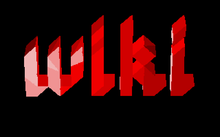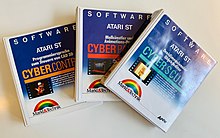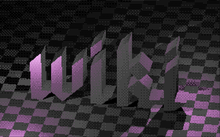Cyber Studio CAD-3D
| Cyber Studio CAD-3D
|
|
|---|---|
 Cyber Studio CAD-3D on an Atari ST. |
|
| Basic data
|
|
| developer | Tom Hudson |
| Publishing year | 1987 |
| Current version | 2.02 |
| operating system | Atari TOS |
Cyber Studio CAD-3D 2.0 is historical 3D graphics software for the Atari ST . It is used for the construction and animation of 3D objects. Cyber Studio CAD-3D was developed in 1987 by Tom Hudson and published by the US software publisher Antic. Markt + Technik Verlag took over sales in the German-speaking region .
The package consists of the 3D program CAD-3D, the script language Cyber Mate for joining animation sequences and the compression extension Cyber Smash.
Cyber Studio is considered one of the early 3D animation packages developed for the home market . It was popular during the Atari ST's most successful years between 1987 and 1991.
Use and performance characteristics
Cyber Studio CAD-3D runs on computers of the Atari ST series with a main memory of 512 KB RAM or more, but only develops its performance from 1 MB RAM.
Cyber Studio CAD-3D has enabled users to model 3D objects by creating bodies of revolution for rotationally symmetrical figures such as cones or wine glasses or extrusions where the contour is cut out like a board. Cyber Studio CAD-3D also has a number of basic graphic elements such as a cube, three types of spheres and a torus.
Modeled objects can be represented three-dimensionally. In the construction view , this is done as a wire frame model in up to four views (front, side, from above and with a freely adjustable camera). A more elaborately calculated “superview” generated solid models with lighting and shading effects. Up to three independent light sources can be freely positioned. Ambient light is also available.
More complex 3D models can be created from simpler models through the use of Boolean operations. Objects can be added to one another, subtracted from one another or logically linked to one another.
Cyber Mate
Cyber Mate is a real-time animation language that is suitable for the compilation and reproduction of the individual images generated from CAD-3D as animations. It was developed by Mark Kimball and is based on the Forth syntax. With Cyber Mate, individual images and animation sequences can be combined into small cartoons and combined with music and sound effects. Since the Atari ST had very limited memory, the implementation of a simple delta compression, in which only the differences between the individual images of an animation are saved, helped.
Extensions
Cyber Studio CAD-3D was the main part of a series of extensions published by Antic-Verlag or as shareware.
Cyber Paint
This cell animation and drawing program developed by Jim Kent is used for creating 2D animations or for processing 3D animations created with Cyber Studio CAD-3D. The user can scroll through individual images of an animation and make changes or add image elements. With an ADO f / x generator, which was powerful for the time, cut graphics or entire animations can be animated.
Cyber Control
A programming language similar to BASIC for controlling all CAD 3D functions was developed by Tom Hudson. By using Cyber Control, CAD-3D is expanded by two additional cameras. A spline generator ensures smooth movements of the camera or objects in three-dimensional space and can be used to model shapes that appear natural.
Cyber Sculpt
This is a 3D modeling program developed by Tom Hudson that can be used both as a stand-alone product and as a complement to CAD-3D. Cyber Sculpt enables the creation and design of complex 3D objects of all kinds, e.g. B. Objects like a screwdriver or a human head.
Further expansion programs
In the years after the publication of Cyber Studio CAD-3D, a number of smaller extensions were programmed:
- "Cyber Texture" for primitive texture mapping .
- "RezRender" for simple ray tracing .
- “Cyber VCR” for recording animations on a video recorder .
- "GIST" for music and sound effects.
- "Anti-Aliasing" for the subsequent addition of anti-aliasing to individual images in order to counteract the low image resolution.
3D data design disks from Antic
Antic Verlag and Markt + Technik published so-called design disks with finished 3D models such as primitive cartoon characters, the human skeleton or 3D fonts:
- Human Design Disk
- Future Design Disk
- Architectural Design Disk
- 3D Font Disk 1 and 2
- Microbot Design Disk
- Cartoon design disk
- Videotitling Design Disk
Reviews
In issue 02/88 of the 68000 magazine from Markt + Technik the conclusion of the test report was: “The CAD 3D / Cyber Control / Cyber Paint package does what it promises. However, one shouldn't expect miracles. It's still pretty hard work designing and programming a 3D animation. "
In issue 11/87 of the " ST Computer " magazine the potential of Cyber Studio CAD-3D was described in the following words: "So far I have not seen anything comparable from another side. The openness of the system is particularly worth mentioning. For $ 30 you can get it 3D Developers Disk, which enables access to CAD-3D from your own programs through so-called pipelines. "
legacy
Cyber Studio CAD-3D and the associated programs showed the possibilities of 3D modeling and animation. After completing his development work on the Atari ST, Tom Hudson developed the first version of 3D Studio for MS-DOS together with some of his colleagues .
Individual evidence
- ↑ a b CAD-3D 2.0: The third dimension. In: ST Computer Magazin. Merlin Computer GmbH, November 1, 1987, accessed on March 28, 2020 .
- ↑ Martin Doudoroff: CAD-3D & CAD-3D 2.0 (Cyber Studio). In: https://doudoroff.com/atari/ . Martin Doudoroff, 2002, accessed on March 28, 2020 .
- ↑ Review CAD-3D. In: ST-Log Magazine. ANTIC Publishing, July 1988, accessed March 28, 2020 .
- ↑ Gregg Pearlmann: Desktop Video for the ST: Cyber software challenges $ 10,000 workstations. In: START Magazine. ANTIC Publishing, April 1988, accessed March 28, 2020 .
- ↑ Martin Doudoroff: Cyber Mate (Cyber Studio). In: https://doudoroff.com/atari/ . Martin Doudoroff, 2002, accessed on March 28, 2020 .
- ^ Martin Doudoroff: Cyber Paint. In: https://doudoroff.com/atari/ . Martin Doudoroff, 2002, accessed on March 28, 2020 .
- ^ Martin Doudoroff: Cyber Texture. In: https://doudoroff.com/atari/ . Martin Doudoroff, 2002, accessed on March 28, 2020 .
- ↑ Richard Parker and Philipp Burgess: RezRender: Ray Tracing and More on Your ST! In: START Magazine. ANTIC Publishing, November 1989, accessed March 28, 2020 .
- ↑ Martin Doudoroff: Future Design, Architectural Design, Human Design and Microbot Design Disks. In: https://doudoroff.com/atari/ . Martin Doudoroff, 2002, accessed on March 28, 2020 .
- ↑ Cyber-Paint: Dance of the Pixels. In: 68000er. Markt + Technik Verlag, February 1988, accessed on March 28, 2020 .
- ↑ CGP Staff: The History of 3D Studio - Tom Hudson interview. In: cgpress.org. CG Artists' Press, February 25, 2010, accessed March 28, 2020 .




